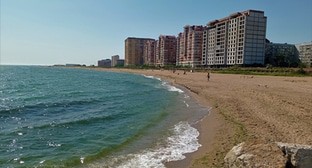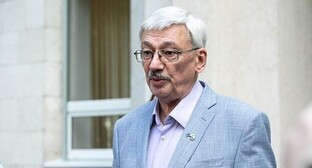27 April 2003, 15:22
Sochi
City in Krasnodar kray(region), kray subordination, 270 km south-east of Krasnodar, seaside balneotherapeutic and climatic health resort of All-Russia level.
Sochi is an urban agglomeration of 3,506 sq. km, stretching along the Black Sea coast of the Caucasus for 145 km from the river of Shepsy in the north-west to the river of Psou in the south-east at the border with Georgia (Abkhazia). Includes Adler, Khosta, Central and Lazarevskoye districts with resort settlements (from the north-west to the south-east): Magri, Makopse, Ashe, Lazarevskoye, Golovinka, Loo, Dagomys, Mamayka, Khosta, Kudepsta, Adler. In the north-east, east and south-east, the territory of Sochi is surrounded by ridges of the Greater Caucasus: Alek, Mamaysky, Bytkha; the mountain of Akhun, etc. (height from 300 to 1,100 m), which protect the seaside from cold northern and eastern winds in winter. The climate is subtropical and wet. Winter is very mild, with unstable weather and frequent lingering rains; the temperature in January averages to 6?С. Spring is early, with unstable rainy weather. Summer is very warm, fair weather with some cloud predominating. Since June, the day-time air temperature is not lower than 20?C; in July and August, it quite often exceeds 25-28?C, but the effect of the heat is softened by sea-breezes. Autumn is long, warm and sunny; its is the best season in Sochi. Precipitations are about 1,400 mm a year. The bathing season is from June to the end of October (seawater temperature in July - August is 24-26?C). The territory of Sochi is crossed by the railway line connecting the NORTHERN Caucasus to Transcaucasia (Krasnodar - Tuapse - Sochi - Sokhumi - Samtredia (Georgia), and Black Sea highway. A sea passenger port. Airport (Adler). Population (1992 est.) 344.2 thousand, (1897 est.) 1.3 thousand, (1926 est.) 13 thousand, (1939 est.) 71 thousand, (1959 est.) 127 thousand, (1970 est.) 224 thousand, (1979 est.) 287 thousand.
In 1838, a landing party of the Black Sea fleet founded a fort of Aleksandria at the site of the Central district of present Sochi (fragments of stone fortifications held out near the Sochi beacon). In 1839, it was renamed into the fort of Navaginsky. During the Crimean War of 1853-1856, the fortification was left by Russian troops. It was re-built in 1864 as a post of Dakhovsky (referred to as Dakhovsky Posad since 1874) and inhabited mostly by retired soldiers and sailors. In 1896б the settlement was called Sochi (derived from "Shatche" or "Soatshe", the Ubykh name of the river flowing here into the sea) and received the status of city, an okrug district) centre of the Black Sea government (province).
From the beginning of the 20th century, Sochi has been developing as resort city. In 1902, development of Matsesta springs of sulphide - sodium chloride water in medicinal purposes started. In 1909, the health resort of Caucasian Riviera (two 4-storeyed hotels, a hydropathic, photo- and electrotherapeutic establishment with sea-water baths and a beach, a theatre, a restaurant etc. were opened; they have been partially preserved at the centre of Sochi). In 1913, Sochi was visited by more than 10 thousand people; in 1933, by about 50 thousand. In the 1930s and later, there were wide-scale road, hydro-geological and mining operations, construction of new sanatoriums, gardening of the territory, improvement of municipal services, especially after the plan of general reconstruction of the health resort began to be implemented (1933). A 3-km long seaside quay with pavilions, special platforms, convenient descents to the sea was constructed. Architectural and planning work was done under supervision of the architects А.V. Shchusev, L.А. Vesnin, I.V. Zholtovsky. Since 1937, Sochi has been included into Krasnodar kray (region). During the Great Patriotic War of 1941-1945, Sochi became a hospital city. About half-million soldiers and officers returned to the front after treatment in Sochi hospitals. In 1961, borders of the health resort city of Sochi were extended by inclusion of Lazarevskoye and Adler districts.
At the beginning of the 1990s, Sochi had about 220 sanatoriums and other health-improving establishments (for 81 thousand people in summer and for 55 thousand in winter). Every year, they provide package holidays for over one million people. In the summer-autumn season, the warm sea, beaches (totalling to 138), sunny weather attract about two millions holiday-makers preferring informal rest.
Alongside with climate, the primary natural medical factor of the health resort is sulphide sodium chloride water of Matsesta (about 30 boreholes; the water is used for baths, lavages, inhalations, etc.). The health resort possesses carbonic mineral waters in the area of Krasnaya Polyana (including arsenic-rich carbonic water Sochi Narzan), used for baths and peroral treatment of stomach and intestine, cardiovascular and nervous systems, as well as iodide-bromine and other mineral water. Fangotherapy in the Sochi sanatoriums is carried out with clayey chalybeate oozes of the Imeretinsky Bay (the area of Adler).
In addition to climatic, thalassotherapy and mud-bath cure, curative gymnastics, physiotherapeutic and other methods of complex treatment are applied here. The leading role in selecting patients for treatment in Sochi is played by the balneal factor, Matsesta baths. The primary indications for treatment include diseases of blood circulation organs, the locomotor system, the nervous system, dermatoses, gynaecological illnesses; Adler and Lazarevskoye areas also provide treatment of untubercular diseases of respiration organs, functional disorders of the nervous system.
Sochi industry serves the needs of the health resort, its leading branch being flavouring one (a dairy, a meat-processing plant, a cannery, a battery farm, etc.); large building organisations. Institute of Resort and Tourism. A theatre. A circus. The Museum of Sochi as a Health Resort City; the Literary Memorial of the writer N.A. Ostrovsky; an art museum; the Museum of Adler Area History; the ethnographic museum (in the settlement of Lazarevskoye); the Memorial Cottage of the singer V.V. Barsova; the Memorial garden Tree of Friendship etc. Sochi is the site of different musical and film festivals, contests, sporting competitions, etc.
Sochi is a large centre of tourism, one of the main ports of call of the Black Sea cruises. Sochi is a waypoint of dozens of All-Russian tourist routes. Sochi has a tourist complex of Dagomys, tourist centres, camping-sites, hotels. Major remarkable and popular sights include the mountain of Akhun (663 m high) with a 30-meter view tower; Agur water-falls; Orliniye rocks; a reserved yew-boxtree grove in Khosta; a park of subtropical vegetation in Adler; Vorontsov cave, Krasnaya Polyana.
In the Central district, the coast line forms the so-called Sochi cape, where the city centre is. The thoroughfare of central Sochi, Kurortny Prospect (built in 1934-1936), going nearly in parallel to the coast line, integrates parks, squares, complexes of large sanatoriums, hotels, boarding houses situated both above and below it along the descents to the sea formed by Vereshchaginsky and Bytkha ridges. In the early 1930s, buildings and sanatorium complexes were built in the style of constructivism (the sanatorium Gorny vozdukh, 1931, architects A.A. and L.А. Vesnins, nowadays within the Zarya sanatorium); the sanatorium of the Ministry of Defense, 1931-1933, architects M.I. Merzhanov, etc.), since the mid-1930s, the primary style of building was different versions of neoclassics (the sanatoriums: Pravda, 1936, architect P.P. Yeskov; Metallurg, 1956, architect Y.О. Svirsky; the building of the Zimny Theatre, 1936, architect К.N. Chernopyatov). Extremely original are buildings of the railway station with a high clock tower (1952, architect A.N. Dushkin) and the marine passenger terminal (1955, architect К.S. Alabyan), varying motives of the Head Admiralty in St Petersburg. Since the mid-1960s, numerous resort and public buildings in the spirit of modern architecture were erected, including international youth centre Sputnik (1960, architects N.V. Milova, G.S. Rzhevskaya, etc.), the hotels of Kavkaz, Leningrad, Magnolia (1964-1966, architect L.Y. Galperin with co-authors), the commercial gallery in central Sochi (1970 - the early 1990s, architect Y.B. Antsut). New areas of resort construction, including Adler, the area of Novy Sochi in the north-western part of the city, the settlement of Dagomys, etc. were developed. Residential construction originally carried out in valleys of rivers was transferred to slopes of the foothills (the microdistricts of Mamayka, Bythha etc.) since the early 1970s. Matsesta is to the south from the ridge of Bytkha, in the valley of the Bytha River. The territory of the health resort is crossed by numerous mountain rivers and streams flowing into the Black Sea: Makopse, Ashe, Psezuape, Shakhe, Dagomys, Mamayka, Sochi, Matsesta, Khosta, Mzymta, etc.; in summer, most of them dry up almost completely. The Sochi territory is filled with evergreen kinds of trees and bushes, characteristic primarily for subtropics: cacti, cedars, cypresses, magnolias, palms, eucalypti, etc. Especially rich in flora and improved are the Arboretum, the park Riviera, etc. The mountain-woodland belt of slopes of the Greater Caucasus consists of spruce, fir, beech, hornbeam, as well as wild fruit and nut trees; above them, there are subalpine and alpine meadows.
The Sochi natural national park s to the north from Sochi, on the north-west slope of the Greater Caucasus. Its area is 190 thousand hectares.




